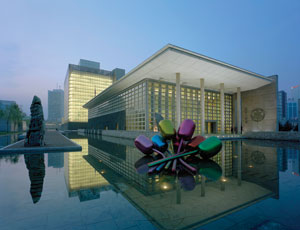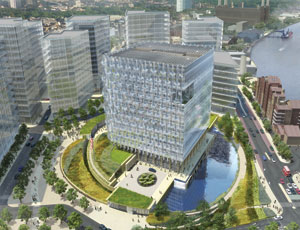The State Dept. is pushing ahead with plans to embrace “design excellence” in its embassy construction program, using some elements for a new U.S. embassy in London, now in design, and fleshing out details through a series of documents that will spell out specific Design Excellence program guidelines.


The department's Bureau of Overseas Buildings Operations (OBO), which manages the construction program, announced the Design Excellence effort in April 2010, when it issued general “guiding principles.” The principles draw on recommendations of a 2009 American Institute of Architects task force.
The Design Excellence initiative is not simply aiming for buildings that are beautiful on the outside but much more energy-efficient and environmentally sustainable on the inside.
Moreover, the initiative is reshaping OBO contracting. Adam Namm, OBO's acting director, says that while the bureau did use design-bid-build contracting for certain major facilities, such as embassies in Berlin and Beijing, its “default” contracting method was design-build.
Namm says, “We are now not going to have a default, and we're going to look at both methods of construction for all projects.”
Lydia Muniz, OBO deputy director, says the contracting shift “goes really to the heart of our program.” She adds, “It really sets forth a very clear position for us moving forward—that we're going to use both methods, that we're going to push for design excellence with both, that we need to rely on both because we deal with so many different environments, that we really need to be able to call on each methodology whenever we want.”
Speaking of contracting, William Miner, director of OBO's office of design and engineering, says, “You have to become ambidextrous.”
Or maybe “tridextrous.” Miner says OBO is looking for a “third way” of contracting. In fact, the agency already has used “bridging” and now, on the London project, is accepting early-contractor-involvement proposals. The design contract for the London project was awarded last year to KeiranTimberlake, Philadelphia. OBO also has looked at integrated project delivery.
Muniz says the contractor would come onboard well before OBO normally would hire a firm and “deliver services during design.” Depending on how the contractor performs, OBO could keep the firm on for the construction phase or seek a new contractor.
Submissions for that “early contractor involvement” on the London job are due by the end of April, with an award to be made by the end of June. Groundbreaking is expected in late 2013.
In addition, OBO is moving away from low-bid contracting to a best-value approach, looking at total life-cycle costs. It also is emphasizing sustainability, setting a benchmark of a Leadership in Energy sand Environmental Design Silver rating but aiming higher. OBO is seeking a LEED Platinum rating for the London embassy.
But now OBO is looking to make the Design Excellence program a broader and deeper part of what it does. Since last year, seven in-house working groups have studied OBO areas such as site planning, programming, design goals and standards, and construction and produced more than 60 recommendations for improvements.
Muniz told an April 26 meeting of its industry advisory panel that the bureau will be issuing several new documents. First out will be a guide to Design Excellence, which Muniz describes as a how-to handbook. OBO hopes to release that guide by July.
Next will come “Standards for Design Excellence,” a revision of OBO's design guidelines, expected in early 2012. Down the road, OBO envisions publishing monographs highlighting specific project success stories as well as launching a design awards program.
OBO is modeling its program on the General Services Administration's design excellence plan, launched about 15 years ago.
Rod Ceasar, senior vice president, international, with Caddell Construction Co., Montgomery, Ala., says that, architecturally, “this is definitely an improvement over what the [OBO has] been doing in the past.”
For some projects, OBO had been using a standard embassy design. Ceasar says, “When you're building in countries that are politically volatile, you need to get [embassies] done fast. Unfortunately, [the buildings] did not project the image that the government wanted to project.”
Muniz says that some aspects of the Design Excellence program are already evident on embassy projects that are completed, such as the embassy in Beijing, designed by Skidmore, Owings & Merrill and completed in 2008.
Muniz adds that the program's impact will become more evident in the future. She says, “Two, three, four years from now, you'll really see, I think, a wave of … facilities where it becomes much more apparent that they were done in the spirit of design excellence.”



Post a comment to this article
Report Abusive Comment